The Importance of Employee Benefits as a Strategic HRM Component
VerifiedAdded on 2023/06/12
|16
|3485
|398
Report
AI Summary
This report investigates the significance of employee benefits as a strategic element of Human Resource Management, focusing on ASDA as a case study. It addresses the concept of employee benefits, their importance in organizations, and the specific types used by ASDA to retain employees and enhance business performance. The research questions explore the challenges ASDA faces in the absence of these benefits. A literature review supports these objectives, defining employee benefits as non-cash compensation that motivates and retains employees, leading to improved productivity and business success. The research methodology employs a positivism philosophy and a deductive approach, utilizing survey research to gather quantitative data. The study concludes that employee benefits positively impact employee productivity and business performance, highlighting the value of quantitative methods in data collection and analysis. The report also acknowledges limitations such as funding and time constraints, and anticipates positive outcomes regarding the impact of benefits on employee productivity and business performance.
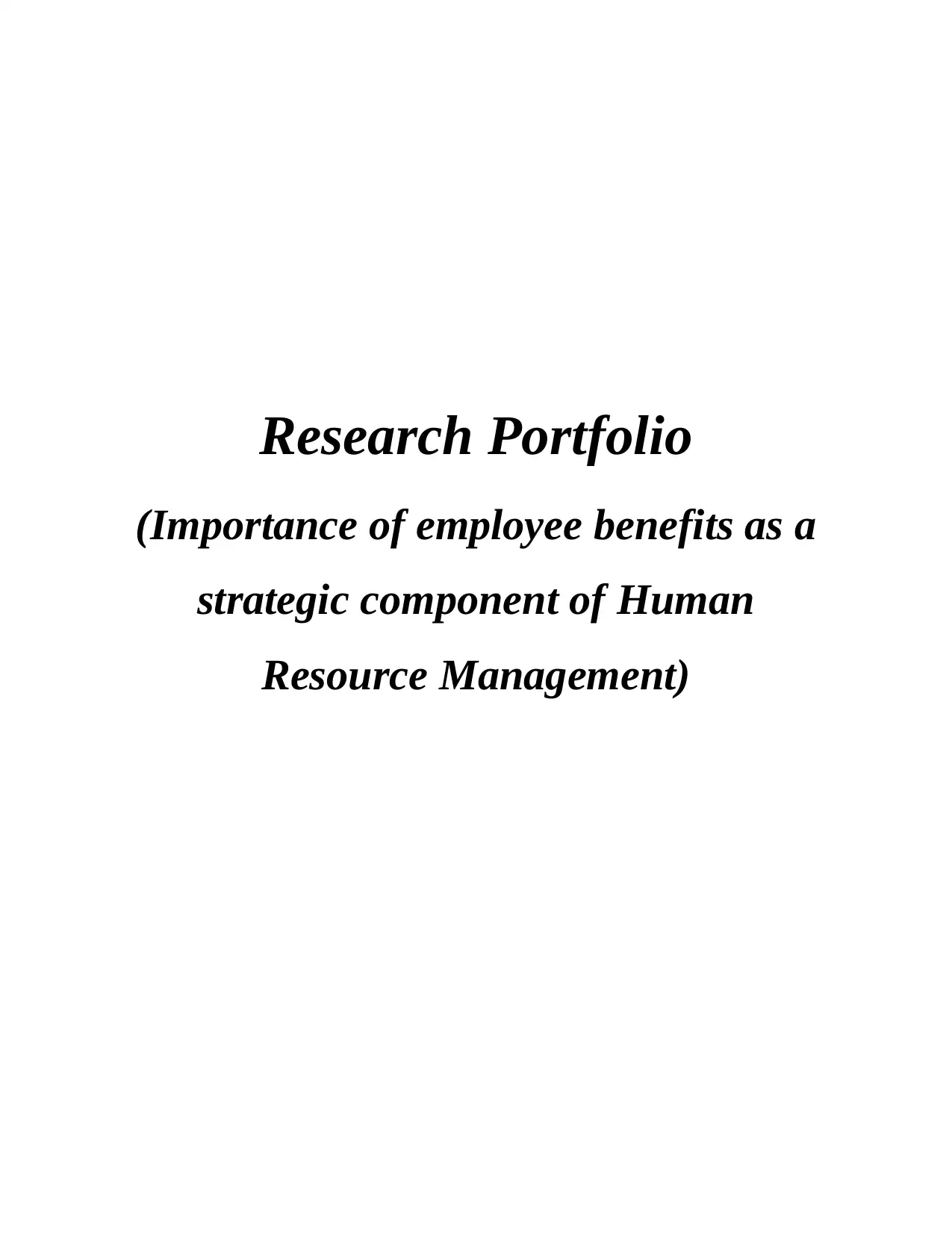
Research Portfolio
(Importance of employee benefits as a
strategic component of Human
Resource Management)
(Importance of employee benefits as a
strategic component of Human
Resource Management)
Paraphrase This Document
Need a fresh take? Get an instant paraphrase of this document with our AI Paraphraser

Table of Contents
INTRODUCTION...........................................................................................................................3
Overview of the topic..................................................................................................................3
Research Questions.....................................................................................................................3
Research Aim and Objectives.....................................................................................................3
LITERATURE REVIEW................................................................................................................4
Explain the concept of employee benefits and its importance within an organisation?.............4
What are the different type of employee benefits used by Asda to retain employees and
improve business performance?..................................................................................................4
What are the challenges faced by Asda in the absence of employee benefits?...........................5
RESEARCH METHODOLOGY.....................................................................................................6
CONCLUSION................................................................................................................................8
REFERENCES................................................................................................................................9
APPENDIX....................................................................................................................................10
Research Ethics Checklist.........................................................................................................10
INTRODUCTION...........................................................................................................................3
Overview of the topic..................................................................................................................3
Research Questions.....................................................................................................................3
Research Aim and Objectives.....................................................................................................3
LITERATURE REVIEW................................................................................................................4
Explain the concept of employee benefits and its importance within an organisation?.............4
What are the different type of employee benefits used by Asda to retain employees and
improve business performance?..................................................................................................4
What are the challenges faced by Asda in the absence of employee benefits?...........................5
RESEARCH METHODOLOGY.....................................................................................................6
CONCLUSION................................................................................................................................8
REFERENCES................................................................................................................................9
APPENDIX....................................................................................................................................10
Research Ethics Checklist.........................................................................................................10
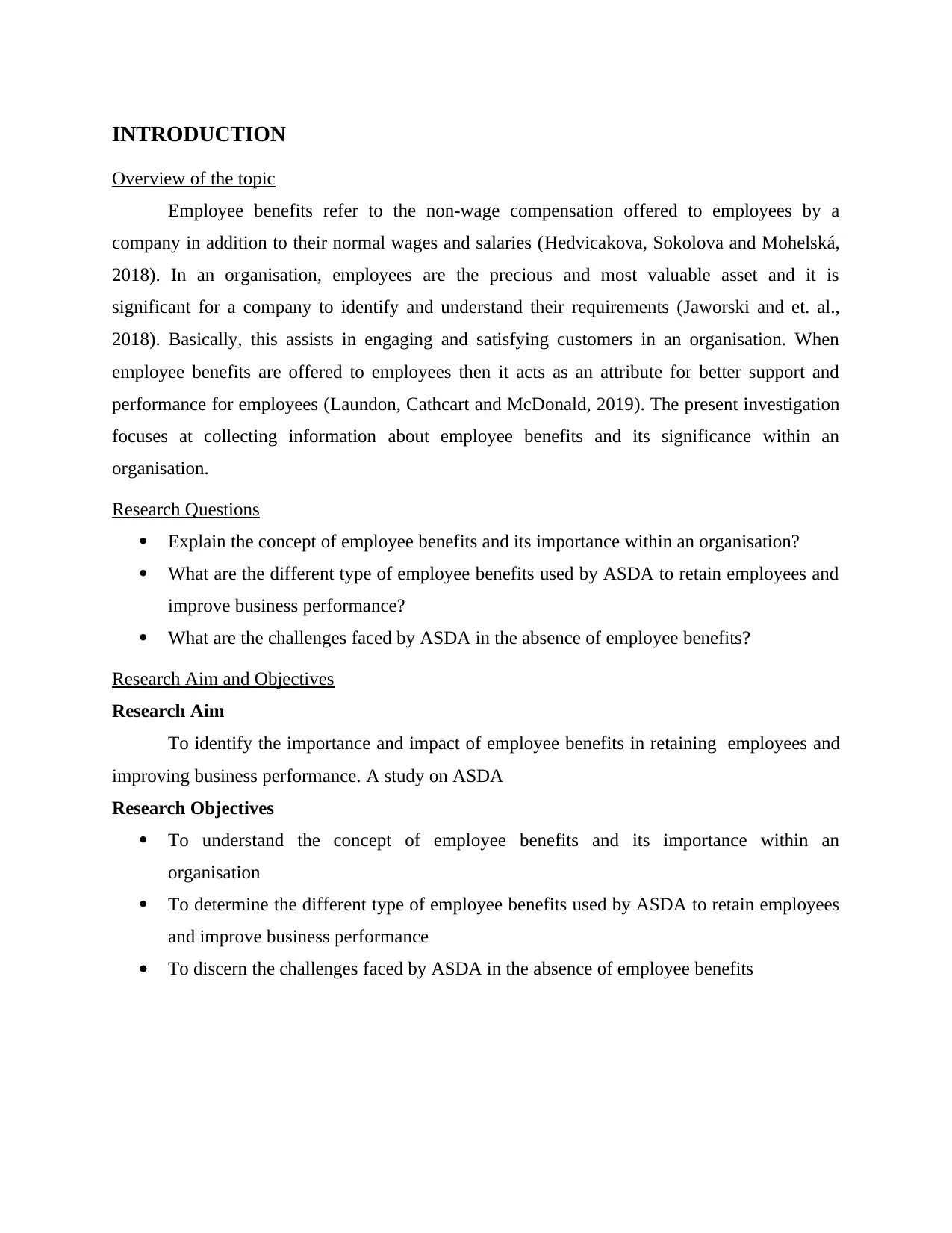
INTRODUCTION
Overview of the topic
Employee benefits refer to the non-wage compensation offered to employees by a
company in addition to their normal wages and salaries (Hedvicakova, Sokolova and Mohelská,
2018). In an organisation, employees are the precious and most valuable asset and it is
significant for a company to identify and understand their requirements (Jaworski and et. al.,
2018). Basically, this assists in engaging and satisfying customers in an organisation. When
employee benefits are offered to employees then it acts as an attribute for better support and
performance for employees (Laundon, Cathcart and McDonald, 2019). The present investigation
focuses at collecting information about employee benefits and its significance within an
organisation.
Research Questions
Explain the concept of employee benefits and its importance within an organisation?
What are the different type of employee benefits used by ASDA to retain employees and
improve business performance?
What are the challenges faced by ASDA in the absence of employee benefits?
Research Aim and Objectives
Research Aim
To identify the importance and impact of employee benefits in retaining employees and
improving business performance. A study on ASDA
Research Objectives
To understand the concept of employee benefits and its importance within an
organisation
To determine the different type of employee benefits used by ASDA to retain employees
and improve business performance
To discern the challenges faced by ASDA in the absence of employee benefits
Overview of the topic
Employee benefits refer to the non-wage compensation offered to employees by a
company in addition to their normal wages and salaries (Hedvicakova, Sokolova and Mohelská,
2018). In an organisation, employees are the precious and most valuable asset and it is
significant for a company to identify and understand their requirements (Jaworski and et. al.,
2018). Basically, this assists in engaging and satisfying customers in an organisation. When
employee benefits are offered to employees then it acts as an attribute for better support and
performance for employees (Laundon, Cathcart and McDonald, 2019). The present investigation
focuses at collecting information about employee benefits and its significance within an
organisation.
Research Questions
Explain the concept of employee benefits and its importance within an organisation?
What are the different type of employee benefits used by ASDA to retain employees and
improve business performance?
What are the challenges faced by ASDA in the absence of employee benefits?
Research Aim and Objectives
Research Aim
To identify the importance and impact of employee benefits in retaining employees and
improving business performance. A study on ASDA
Research Objectives
To understand the concept of employee benefits and its importance within an
organisation
To determine the different type of employee benefits used by ASDA to retain employees
and improve business performance
To discern the challenges faced by ASDA in the absence of employee benefits
⊘ This is a preview!⊘
Do you want full access?
Subscribe today to unlock all pages.

Trusted by 1+ million students worldwide
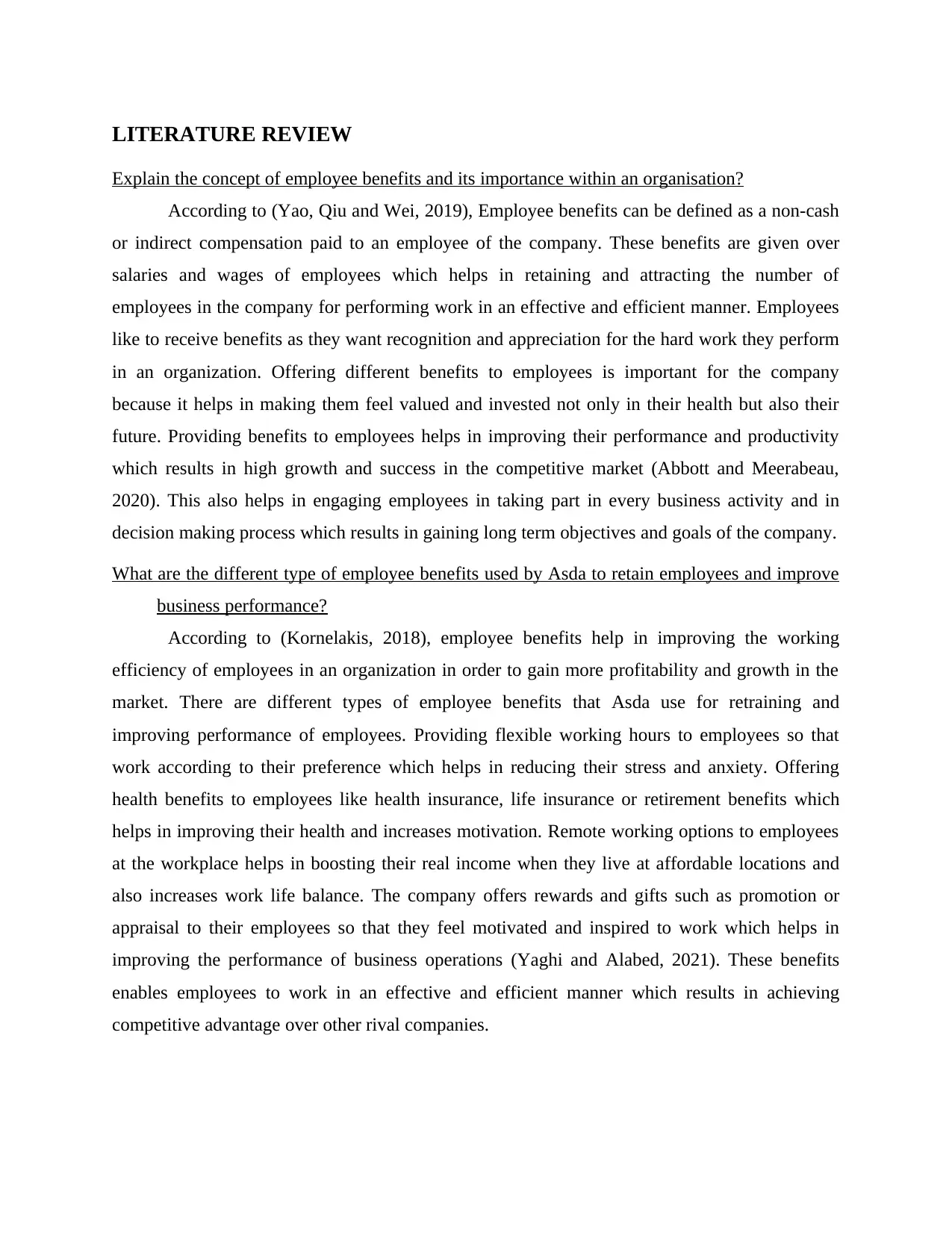
LITERATURE REVIEW
Explain the concept of employee benefits and its importance within an organisation?
According to (Yao, Qiu and Wei, 2019), Employee benefits can be defined as a non-cash
or indirect compensation paid to an employee of the company. These benefits are given over
salaries and wages of employees which helps in retaining and attracting the number of
employees in the company for performing work in an effective and efficient manner. Employees
like to receive benefits as they want recognition and appreciation for the hard work they perform
in an organization. Offering different benefits to employees is important for the company
because it helps in making them feel valued and invested not only in their health but also their
future. Providing benefits to employees helps in improving their performance and productivity
which results in high growth and success in the competitive market (Abbott and Meerabeau,
2020). This also helps in engaging employees in taking part in every business activity and in
decision making process which results in gaining long term objectives and goals of the company.
What are the different type of employee benefits used by Asda to retain employees and improve
business performance?
According to (Kornelakis, 2018), employee benefits help in improving the working
efficiency of employees in an organization in order to gain more profitability and growth in the
market. There are different types of employee benefits that Asda use for retraining and
improving performance of employees. Providing flexible working hours to employees so that
work according to their preference which helps in reducing their stress and anxiety. Offering
health benefits to employees like health insurance, life insurance or retirement benefits which
helps in improving their health and increases motivation. Remote working options to employees
at the workplace helps in boosting their real income when they live at affordable locations and
also increases work life balance. The company offers rewards and gifts such as promotion or
appraisal to their employees so that they feel motivated and inspired to work which helps in
improving the performance of business operations (Yaghi and Alabed, 2021). These benefits
enables employees to work in an effective and efficient manner which results in achieving
competitive advantage over other rival companies.
Explain the concept of employee benefits and its importance within an organisation?
According to (Yao, Qiu and Wei, 2019), Employee benefits can be defined as a non-cash
or indirect compensation paid to an employee of the company. These benefits are given over
salaries and wages of employees which helps in retaining and attracting the number of
employees in the company for performing work in an effective and efficient manner. Employees
like to receive benefits as they want recognition and appreciation for the hard work they perform
in an organization. Offering different benefits to employees is important for the company
because it helps in making them feel valued and invested not only in their health but also their
future. Providing benefits to employees helps in improving their performance and productivity
which results in high growth and success in the competitive market (Abbott and Meerabeau,
2020). This also helps in engaging employees in taking part in every business activity and in
decision making process which results in gaining long term objectives and goals of the company.
What are the different type of employee benefits used by Asda to retain employees and improve
business performance?
According to (Kornelakis, 2018), employee benefits help in improving the working
efficiency of employees in an organization in order to gain more profitability and growth in the
market. There are different types of employee benefits that Asda use for retraining and
improving performance of employees. Providing flexible working hours to employees so that
work according to their preference which helps in reducing their stress and anxiety. Offering
health benefits to employees like health insurance, life insurance or retirement benefits which
helps in improving their health and increases motivation. Remote working options to employees
at the workplace helps in boosting their real income when they live at affordable locations and
also increases work life balance. The company offers rewards and gifts such as promotion or
appraisal to their employees so that they feel motivated and inspired to work which helps in
improving the performance of business operations (Yaghi and Alabed, 2021). These benefits
enables employees to work in an effective and efficient manner which results in achieving
competitive advantage over other rival companies.
Paraphrase This Document
Need a fresh take? Get an instant paraphrase of this document with our AI Paraphraser
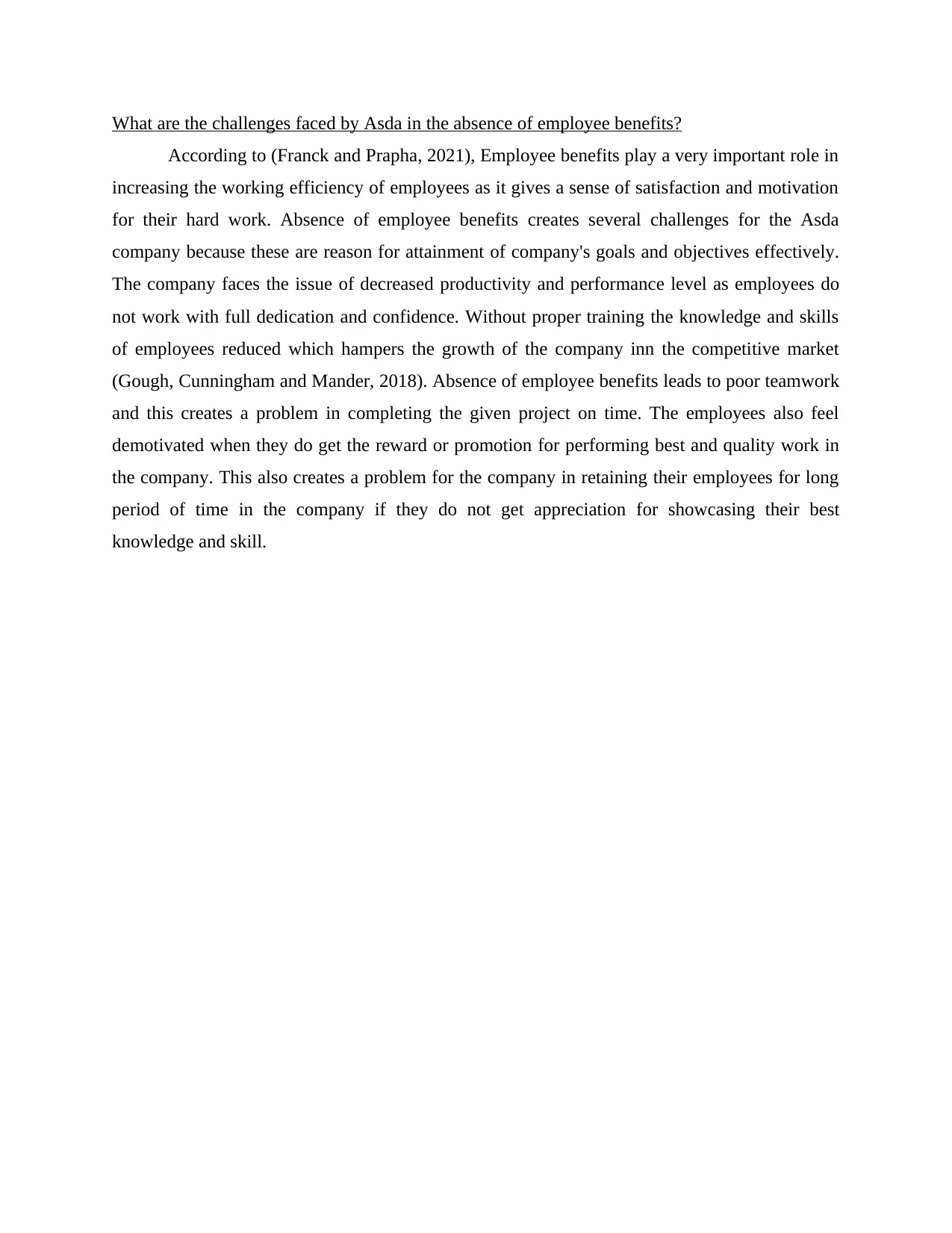
What are the challenges faced by Asda in the absence of employee benefits?
According to (Franck and Prapha, 2021), Employee benefits play a very important role in
increasing the working efficiency of employees as it gives a sense of satisfaction and motivation
for their hard work. Absence of employee benefits creates several challenges for the Asda
company because these are reason for attainment of company's goals and objectives effectively.
The company faces the issue of decreased productivity and performance level as employees do
not work with full dedication and confidence. Without proper training the knowledge and skills
of employees reduced which hampers the growth of the company inn the competitive market
(Gough, Cunningham and Mander, 2018). Absence of employee benefits leads to poor teamwork
and this creates a problem in completing the given project on time. The employees also feel
demotivated when they do get the reward or promotion for performing best and quality work in
the company. This also creates a problem for the company in retaining their employees for long
period of time in the company if they do not get appreciation for showcasing their best
knowledge and skill.
According to (Franck and Prapha, 2021), Employee benefits play a very important role in
increasing the working efficiency of employees as it gives a sense of satisfaction and motivation
for their hard work. Absence of employee benefits creates several challenges for the Asda
company because these are reason for attainment of company's goals and objectives effectively.
The company faces the issue of decreased productivity and performance level as employees do
not work with full dedication and confidence. Without proper training the knowledge and skills
of employees reduced which hampers the growth of the company inn the competitive market
(Gough, Cunningham and Mander, 2018). Absence of employee benefits leads to poor teamwork
and this creates a problem in completing the given project on time. The employees also feel
demotivated when they do get the reward or promotion for performing best and quality work in
the company. This also creates a problem for the company in retaining their employees for long
period of time in the company if they do not get appreciation for showcasing their best
knowledge and skill.
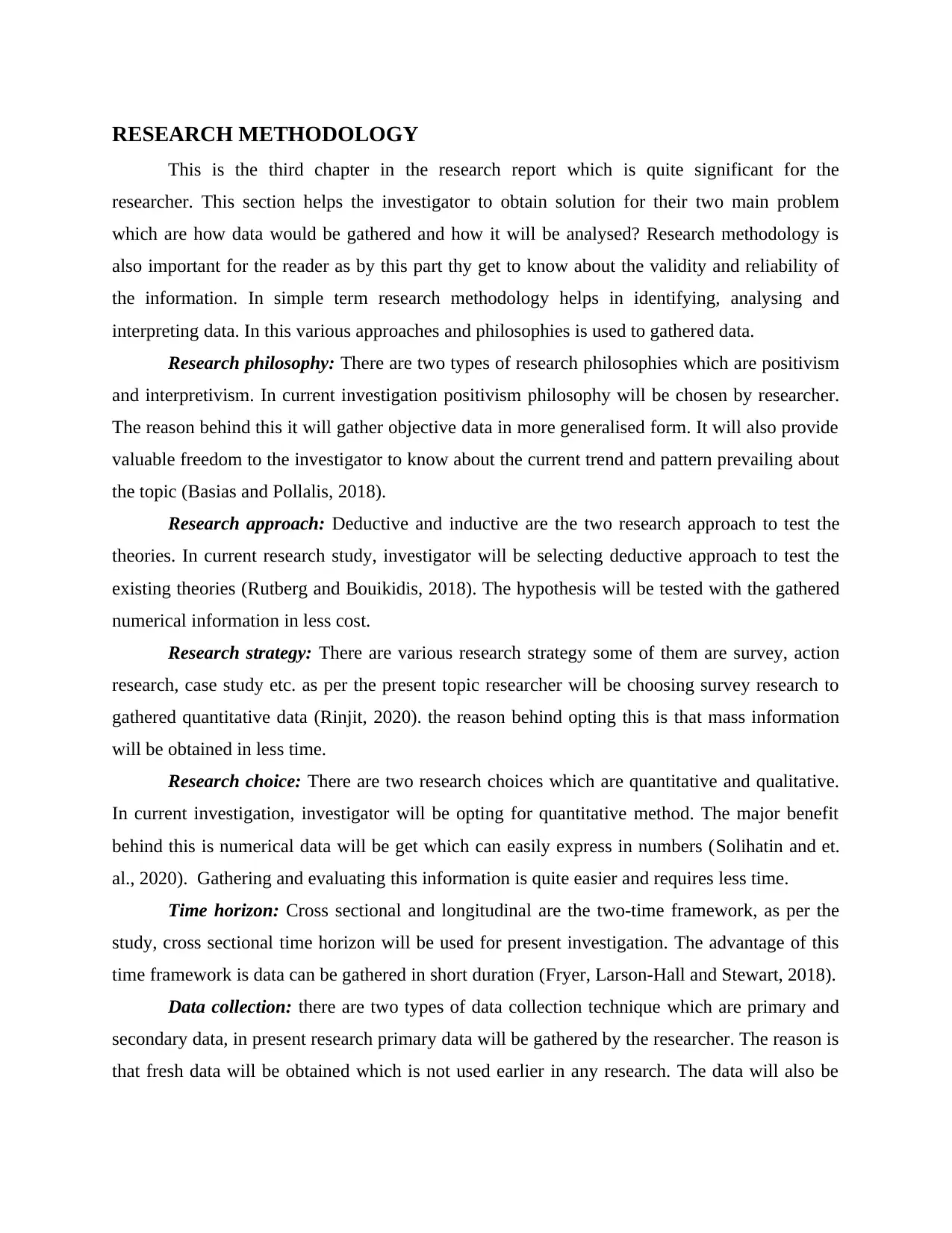
RESEARCH METHODOLOGY
This is the third chapter in the research report which is quite significant for the
researcher. This section helps the investigator to obtain solution for their two main problem
which are how data would be gathered and how it will be analysed? Research methodology is
also important for the reader as by this part thy get to know about the validity and reliability of
the information. In simple term research methodology helps in identifying, analysing and
interpreting data. In this various approaches and philosophies is used to gathered data.
Research philosophy: There are two types of research philosophies which are positivism
and interpretivism. In current investigation positivism philosophy will be chosen by researcher.
The reason behind this it will gather objective data in more generalised form. It will also provide
valuable freedom to the investigator to know about the current trend and pattern prevailing about
the topic (Basias and Pollalis, 2018).
Research approach: Deductive and inductive are the two research approach to test the
theories. In current research study, investigator will be selecting deductive approach to test the
existing theories (Rutberg and Bouikidis, 2018). The hypothesis will be tested with the gathered
numerical information in less cost.
Research strategy: There are various research strategy some of them are survey, action
research, case study etc. as per the present topic researcher will be choosing survey research to
gathered quantitative data (Rinjit, 2020). the reason behind opting this is that mass information
will be obtained in less time.
Research choice: There are two research choices which are quantitative and qualitative.
In current investigation, investigator will be opting for quantitative method. The major benefit
behind this is numerical data will be get which can easily express in numbers (Solihatin and et.
al., 2020). Gathering and evaluating this information is quite easier and requires less time.
Time horizon: Cross sectional and longitudinal are the two-time framework, as per the
study, cross sectional time horizon will be used for present investigation. The advantage of this
time framework is data can be gathered in short duration (Fryer, Larson-Hall and Stewart, 2018).
Data collection: there are two types of data collection technique which are primary and
secondary data, in present research primary data will be gathered by the researcher. The reason is
that fresh data will be obtained which is not used earlier in any research. The data will also be
This is the third chapter in the research report which is quite significant for the
researcher. This section helps the investigator to obtain solution for their two main problem
which are how data would be gathered and how it will be analysed? Research methodology is
also important for the reader as by this part thy get to know about the validity and reliability of
the information. In simple term research methodology helps in identifying, analysing and
interpreting data. In this various approaches and philosophies is used to gathered data.
Research philosophy: There are two types of research philosophies which are positivism
and interpretivism. In current investigation positivism philosophy will be chosen by researcher.
The reason behind this it will gather objective data in more generalised form. It will also provide
valuable freedom to the investigator to know about the current trend and pattern prevailing about
the topic (Basias and Pollalis, 2018).
Research approach: Deductive and inductive are the two research approach to test the
theories. In current research study, investigator will be selecting deductive approach to test the
existing theories (Rutberg and Bouikidis, 2018). The hypothesis will be tested with the gathered
numerical information in less cost.
Research strategy: There are various research strategy some of them are survey, action
research, case study etc. as per the present topic researcher will be choosing survey research to
gathered quantitative data (Rinjit, 2020). the reason behind opting this is that mass information
will be obtained in less time.
Research choice: There are two research choices which are quantitative and qualitative.
In current investigation, investigator will be opting for quantitative method. The major benefit
behind this is numerical data will be get which can easily express in numbers (Solihatin and et.
al., 2020). Gathering and evaluating this information is quite easier and requires less time.
Time horizon: Cross sectional and longitudinal are the two-time framework, as per the
study, cross sectional time horizon will be used for present investigation. The advantage of this
time framework is data can be gathered in short duration (Fryer, Larson-Hall and Stewart, 2018).
Data collection: there are two types of data collection technique which are primary and
secondary data, in present research primary data will be gathered by the researcher. The reason is
that fresh data will be obtained which is not used earlier in any research. The data will also be
⊘ This is a preview!⊘
Do you want full access?
Subscribe today to unlock all pages.

Trusted by 1+ million students worldwide
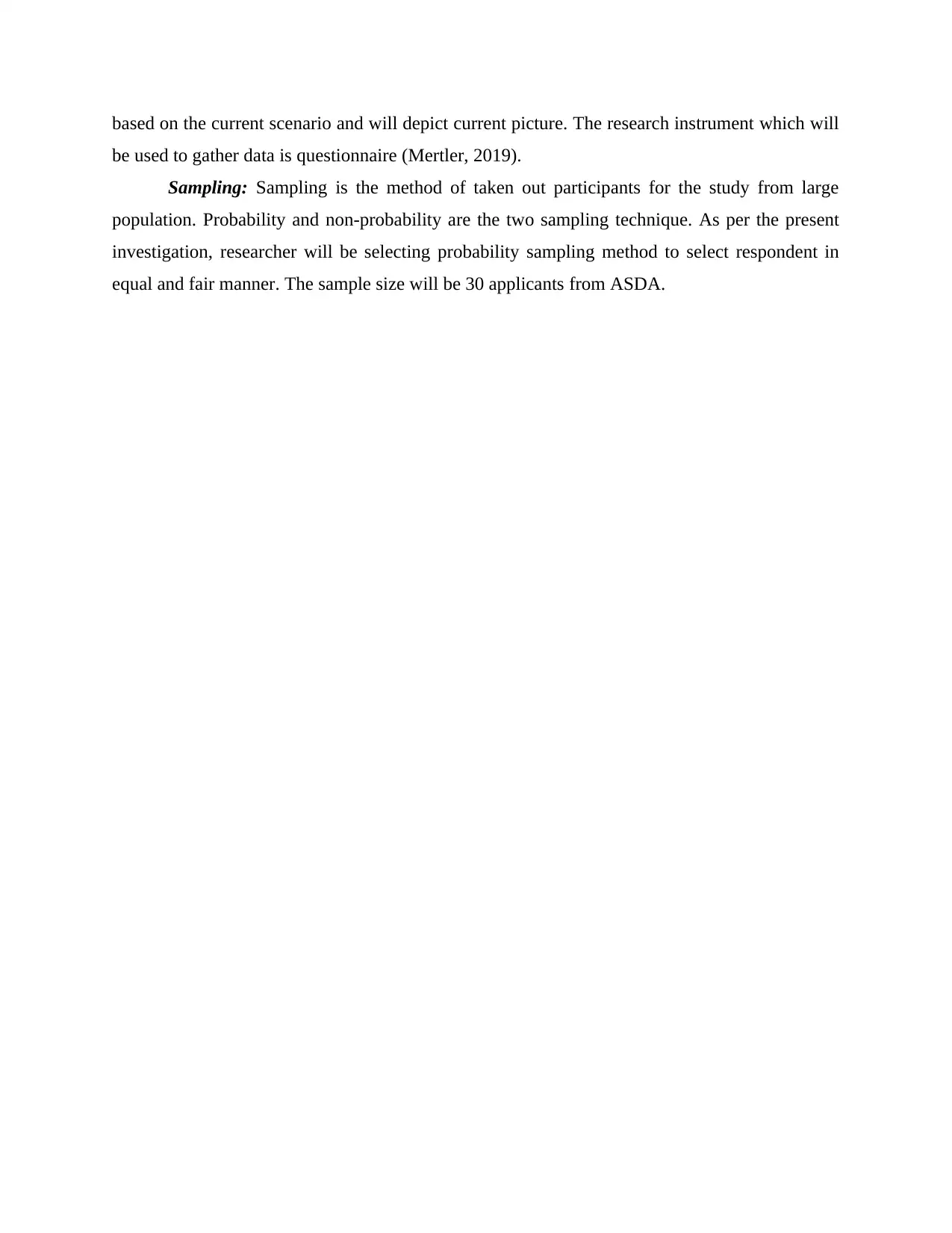
based on the current scenario and will depict current picture. The research instrument which will
be used to gather data is questionnaire (Mertler, 2019).
Sampling: Sampling is the method of taken out participants for the study from large
population. Probability and non-probability are the two sampling technique. As per the present
investigation, researcher will be selecting probability sampling method to select respondent in
equal and fair manner. The sample size will be 30 applicants from ASDA.
be used to gather data is questionnaire (Mertler, 2019).
Sampling: Sampling is the method of taken out participants for the study from large
population. Probability and non-probability are the two sampling technique. As per the present
investigation, researcher will be selecting probability sampling method to select respondent in
equal and fair manner. The sample size will be 30 applicants from ASDA.
Paraphrase This Document
Need a fresh take? Get an instant paraphrase of this document with our AI Paraphraser

CONCLUSION
From the above assembled data, it is summarised that employees are the precious asset in
an organisation and for making them satisfied in the organisation they use different types of
employee benefits such as rewards, appreciation, additional monetary benefits etc. As per the
above data, benefits are offered to employees so that they stay in the organisation and perform
their work with greater efficiency and effectiveness.
While conducting investigation, there are certain limitations that could become barrier in
the path of conducting research which are: lack of funds, lack of time management, biased
respondents etc.
The expected results of the present investigation is that there is positive impact of
employee benefits over the productivity of the employees and performance of the business. It is
also identified that quantitative research methods are appropriate to collect and evaluate data in a
systematic way.
From the above assembled data, it is summarised that employees are the precious asset in
an organisation and for making them satisfied in the organisation they use different types of
employee benefits such as rewards, appreciation, additional monetary benefits etc. As per the
above data, benefits are offered to employees so that they stay in the organisation and perform
their work with greater efficiency and effectiveness.
While conducting investigation, there are certain limitations that could become barrier in
the path of conducting research which are: lack of funds, lack of time management, biased
respondents etc.
The expected results of the present investigation is that there is positive impact of
employee benefits over the productivity of the employees and performance of the business. It is
also identified that quantitative research methods are appropriate to collect and evaluate data in a
systematic way.

REFERENCES
Books and Journals
Abbott, P. and Meerabeau, L., 2020. Professionals, professionalization and the caring
professions. In The sociology of the caring professions (pp. 1-19). Routledge.
Basias, N. and Pollalis, Y., 2018. Quantitative and qualitative research in business & technology:
Justifying a suitable research methodology. Review of Integrative Business and
Economics Research, 7, pp.91-105.
Franck, A. and Prapha, A., 2021. Not in This Together: How supermarkets became pandemic
winners while women workers are losing out.
Fryer, L.K., Larson-Hall, J. and Stewart, J., 2018. Quantitative methodology. In The Palgrave
handbook of applied linguistics research methodology (pp. 55-77). Palgrave Macmillan,
London.
Gough, C., Cunningham, R. and Mander, S., 2018. Understanding key elements in establishing a
social license for CCS: an empirical approach. International Journal of Greenhouse Gas
Control, 68. pp.16-25.
Hedvicakova, M., Sokolova, M. and Mohelská, H., 2018. THE IMPACT OF ECONOMIC
GROWTH ON WAGES AND THE SUPPLY OF EMPLOYEE BENEFITS IN THE
CZECH REPUBLIC!. Transformations in business & economics, 17(3).
Jaworski and et. al., 2018. The effects of training satisfaction, employee benefits, and incentives
on part-time employees’ commitment. International Journal of Hospitality
Management, 74, pp.1-12.
Kornelakis, A., 2018. Why are your reward strategies not working? The role of shareholder
value, country context, and employee voice. Business Horizons, 61(1). pp.107-113.
Laundon, M., Cathcart, A. and McDonald, P., 2019. Just benefits? Employee benefits and
organisational justice. Employee Relations: The International Journal.
Mertler, C.A., 2019. Quantitative methodology in adolescent research. The Encyclopedia of
Child and Adolescent Development, pp.1-14.
Rinjit, K., 2020. Research methodology.
Rutberg, S. and Bouikidis, C.D., 2018. Focusing on the fundamentals: A simplistic
differentiation between qualitative and quantitative research. Nephrology Nursing
Journal, 45(2), pp.209-213.
Solihatin and et. al., 2020. DEVELOPMENT OF TEACHING MATERIALS"
QUANTITATIVE RESEARCH METHODOLOGY FOR STUDENTS BASED ON QR
CODE. PalArch's Journal of Archaeology of Egypt/Egyptology, 17(5), pp.395-408.
Yaghi, A. and Alabed, N., 2021. Career decision-making difficulties among university students:
does employment status matter?. Higher Education, Skills and Work-Based Learning.
Yao, T., Qiu, Q. and Wei, Y., 2019. Retaining hotel employees as internal customers: Effect of
organizational commitment on attitudinal and behavioral loyalty of
employees. International Journal of Hospitality Management, 76. pp.1-8.
Books and Journals
Abbott, P. and Meerabeau, L., 2020. Professionals, professionalization and the caring
professions. In The sociology of the caring professions (pp. 1-19). Routledge.
Basias, N. and Pollalis, Y., 2018. Quantitative and qualitative research in business & technology:
Justifying a suitable research methodology. Review of Integrative Business and
Economics Research, 7, pp.91-105.
Franck, A. and Prapha, A., 2021. Not in This Together: How supermarkets became pandemic
winners while women workers are losing out.
Fryer, L.K., Larson-Hall, J. and Stewart, J., 2018. Quantitative methodology. In The Palgrave
handbook of applied linguistics research methodology (pp. 55-77). Palgrave Macmillan,
London.
Gough, C., Cunningham, R. and Mander, S., 2018. Understanding key elements in establishing a
social license for CCS: an empirical approach. International Journal of Greenhouse Gas
Control, 68. pp.16-25.
Hedvicakova, M., Sokolova, M. and Mohelská, H., 2018. THE IMPACT OF ECONOMIC
GROWTH ON WAGES AND THE SUPPLY OF EMPLOYEE BENEFITS IN THE
CZECH REPUBLIC!. Transformations in business & economics, 17(3).
Jaworski and et. al., 2018. The effects of training satisfaction, employee benefits, and incentives
on part-time employees’ commitment. International Journal of Hospitality
Management, 74, pp.1-12.
Kornelakis, A., 2018. Why are your reward strategies not working? The role of shareholder
value, country context, and employee voice. Business Horizons, 61(1). pp.107-113.
Laundon, M., Cathcart, A. and McDonald, P., 2019. Just benefits? Employee benefits and
organisational justice. Employee Relations: The International Journal.
Mertler, C.A., 2019. Quantitative methodology in adolescent research. The Encyclopedia of
Child and Adolescent Development, pp.1-14.
Rinjit, K., 2020. Research methodology.
Rutberg, S. and Bouikidis, C.D., 2018. Focusing on the fundamentals: A simplistic
differentiation between qualitative and quantitative research. Nephrology Nursing
Journal, 45(2), pp.209-213.
Solihatin and et. al., 2020. DEVELOPMENT OF TEACHING MATERIALS"
QUANTITATIVE RESEARCH METHODOLOGY FOR STUDENTS BASED ON QR
CODE. PalArch's Journal of Archaeology of Egypt/Egyptology, 17(5), pp.395-408.
Yaghi, A. and Alabed, N., 2021. Career decision-making difficulties among university students:
does employment status matter?. Higher Education, Skills and Work-Based Learning.
Yao, T., Qiu, Q. and Wei, Y., 2019. Retaining hotel employees as internal customers: Effect of
organizational commitment on attitudinal and behavioral loyalty of
employees. International Journal of Hospitality Management, 76. pp.1-8.
⊘ This is a preview!⊘
Do you want full access?
Subscribe today to unlock all pages.

Trusted by 1+ million students worldwide
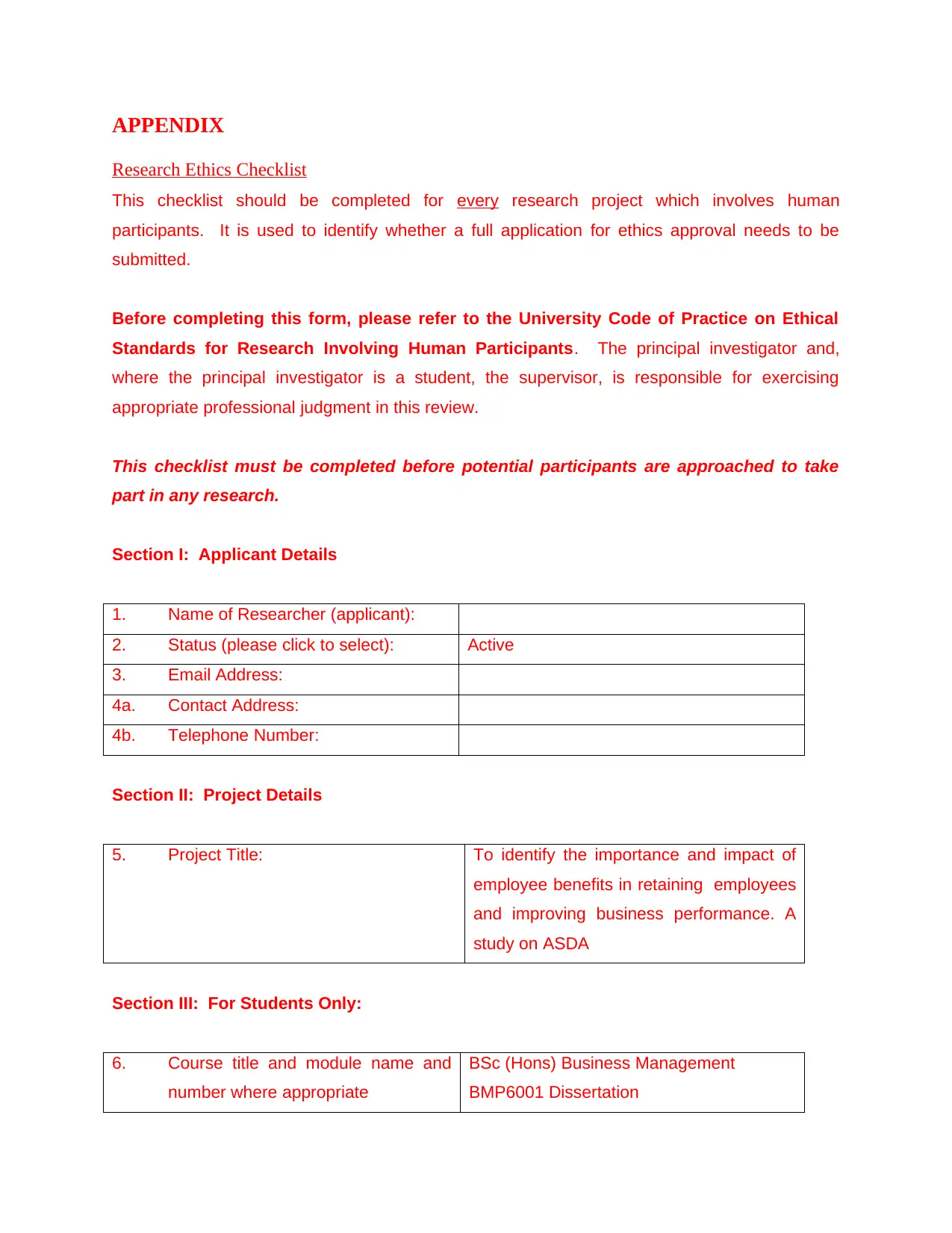
APPENDIX
Research Ethics Checklist
This checklist should be completed for every research project which involves human
participants. It is used to identify whether a full application for ethics approval needs to be
submitted.
Before completing this form, please refer to the University Code of Practice on Ethical
Standards for Research Involving Human Participants. The principal investigator and,
where the principal investigator is a student, the supervisor, is responsible for exercising
appropriate professional judgment in this review.
This checklist must be completed before potential participants are approached to take
part in any research.
Section I: Applicant Details
1. Name of Researcher (applicant):
2. Status (please click to select): Active
3. Email Address:
4a. Contact Address:
4b. Telephone Number:
Section II: Project Details
5. Project Title: To identify the importance and impact of
employee benefits in retaining employees
and improving business performance. A
study on ASDA
Section III: For Students Only:
6. Course title and module name and
number where appropriate
BSc (Hons) Business Management
BMP6001 Dissertation
Research Ethics Checklist
This checklist should be completed for every research project which involves human
participants. It is used to identify whether a full application for ethics approval needs to be
submitted.
Before completing this form, please refer to the University Code of Practice on Ethical
Standards for Research Involving Human Participants. The principal investigator and,
where the principal investigator is a student, the supervisor, is responsible for exercising
appropriate professional judgment in this review.
This checklist must be completed before potential participants are approached to take
part in any research.
Section I: Applicant Details
1. Name of Researcher (applicant):
2. Status (please click to select): Active
3. Email Address:
4a. Contact Address:
4b. Telephone Number:
Section II: Project Details
5. Project Title: To identify the importance and impact of
employee benefits in retaining employees
and improving business performance. A
study on ASDA
Section III: For Students Only:
6. Course title and module name and
number where appropriate
BSc (Hons) Business Management
BMP6001 Dissertation
Paraphrase This Document
Need a fresh take? Get an instant paraphrase of this document with our AI Paraphraser

School/Centre:
7. Supervisor’s or module leader’s
name:
8. Email address:
9. Telephone extension:
Declaration by Researcher (Please tick the appropriate boxes)
I have read the University’s Code of Practice
The topic merits further research
I have the skills to carry out the research
The participant information sheet, if needed, is appropriate
The procedures for recruitment and obtaining informed consent, if needed, are
appropriate
The research is exempt from further ethics review according to current University
guidelines
Where relevant, I have read the ethical guidelines of the regulatory body that is
relevant to my discipline and verify that the research adheres to these guidelines
Comments from Researcher, and/or from Supervisor if Researcher is
Undergraduate or Taught Postgraduate student:
This project meets the standard set by UoB policy named “Code of Practice for Research
Students and Supervisors 2019-20”.
This project also confirms with “UoB Research Ethics Framework”.
7. Supervisor’s or module leader’s
name:
8. Email address:
9. Telephone extension:
Declaration by Researcher (Please tick the appropriate boxes)
I have read the University’s Code of Practice
The topic merits further research
I have the skills to carry out the research
The participant information sheet, if needed, is appropriate
The procedures for recruitment and obtaining informed consent, if needed, are
appropriate
The research is exempt from further ethics review according to current University
guidelines
Where relevant, I have read the ethical guidelines of the regulatory body that is
relevant to my discipline and verify that the research adheres to these guidelines
Comments from Researcher, and/or from Supervisor if Researcher is
Undergraduate or Taught Postgraduate student:
This project meets the standard set by UoB policy named “Code of Practice for Research
Students and Supervisors 2019-20”.
This project also confirms with “UoB Research Ethics Framework”.

Page 12 of 16
⊘ This is a preview!⊘
Do you want full access?
Subscribe today to unlock all pages.

Trusted by 1+ million students worldwide
1 out of 16
Related Documents
Your All-in-One AI-Powered Toolkit for Academic Success.
+13062052269
info@desklib.com
Available 24*7 on WhatsApp / Email
![[object Object]](/_next/static/media/star-bottom.7253800d.svg)
Unlock your academic potential
Copyright © 2020–2025 A2Z Services. All Rights Reserved. Developed and managed by ZUCOL.





